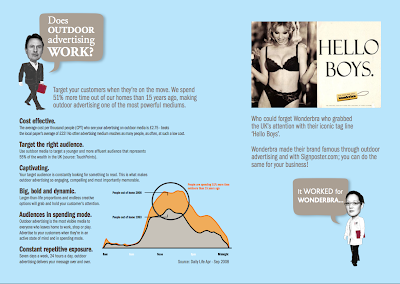As part of my research and ideas for the design for print// Good is.. brief, I am going to propose some billboard designs to promote polka dots at a large fashion event. I am going to look at what they are and how they are used and what effect they have on communication and advertising.
---------------
'A billboard (also called a "hoarding" in the UK and many other parts of the world) is a large outdoor advertising structure (a billing board), typically found in high traffic areas such as alongside busy roads. Billboards present large advertisements to passing pedestrians and drivers. Typically showing large, ostensibly witty slogans, and distinctive visuals, billboards are highly visible in the top designated market areas. Bulletins are the largest, most impactful standard-size billboards. Located primarily on major highways, expressways or principal arterials, they command high-density consumer exposure (mostly to vehicular traffic). Bulletins afford greatest visibility due not only to their size, but because they allow creative "customizing" through extensions and embellishments.
Posters are the other common form of billboard advertising, located chiefly in commercial and industrial areas on primary and secondary arterial roads. Posters are a smaller format than bulletins and are viewed principally by residents and commuter traffic, with some pedestrian exposure.' Wikipedia
These are the standard billboard sizes dependant on how many sheets are used.
-------------
The images above show the costing and size of the billboards available by this particular company. It gives me a rough estimate of how much billboard advertising would cost.
This website came in very handy! Its a company that sells billboards and allows you to pick the location and size of your billboard to meet your specific requirements. This is really useful because it means you can choose an area where you know your advertisement will be seen by your target audience. For example if I was to create one based upon polka dots in contemporary fashion I could have it placed in a town centre where the main shopping area is. Meaning that those who are buying clothes in the city centre may likely to be interested in fashion and would see my billboard, which they could then relate to.
--------------
Billboards gallore..


















































